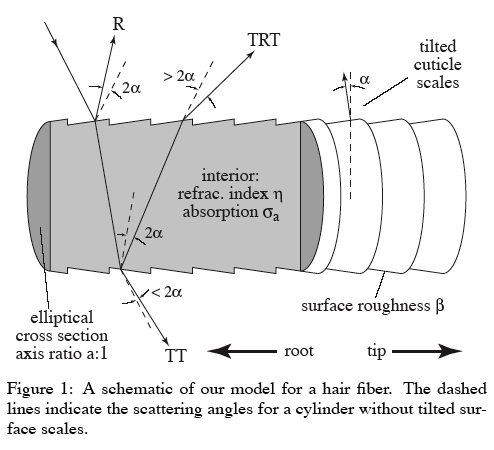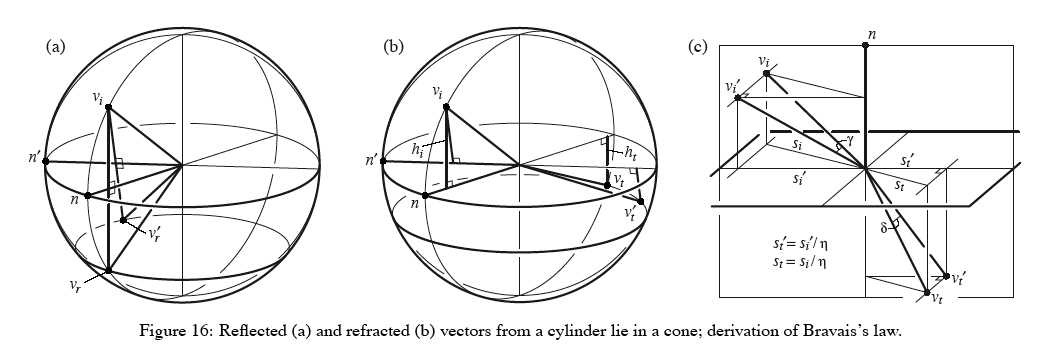2007. 7. 24. 19:41
Method/VFX
 invalid-file
invalid-file
<Light Scattering from Human Hair Fibers>
Henrik Wann Jensen, University of California - San Diego
Mike Cammarano, Stanfornd University
Steve Worley, Worley Laboratories
Pat Hanrahan, Stanford University
Siggraph 2003
http://graphics.stanford.edu/papers/hair/
Abstract
A model of a hair fiber as a transparent elliptical cylinder with an absorbing interior and a surface covered with tilted scales
1 Introduction
Kajiya-Kay model
: the reflection of a parallel beam from the surface of a cylinder and the diffusion proportional to the cosine of the incident angle
Hair is a dielectirc material and translucent.
Goldman simulation
: translucency by adding a directional parameter that controls the relative amount of forward transmission and backward reflection
TY Kim
: a two-term phase function based on ray density argument and Monte Carlo computations
+
Fresnel factor (to handle obilque incidence)
volume absorption
internal reflection
(full 3D hemispherical scattering measurements ->)
1. The primary specular highlight continues all the way around the hair, while the secondary highlight is confined to the side of the hair toward the source.
2. A pair of large out-of-plane peaks, or glints, are present, and as the incidence angle increases the peaks move closer to the incidence plane, eventually merging and disappearing.
3. The scattering distribution depends on the angle of rotation of the hair fiber about its axis. (Because hair fibers are not generally circular in cross section.)
4. Three trasport modes are derived: surfacce reflection, transmission, and internal reflection.
1. The primary specular highlight continues all the way around the hair, while the secondary highlight is confined to the side of the hair toward the source.
2. A pair of large out-of-plane peaks, or glints, are present, and as the incidence angle increases the peaks move closer to the incidence plane, eventually merging and disappearing.
3. The scattering distribution depends on the angle of rotation of the hair fiber about its axis. (Because hair fibers are not generally circular in cross section.)
4. Three trasport modes are derived: surfacce reflection, transmission, and internal reflection.
2 Fibers
2.1 Hair fibers and fiber scattering
The fiber is modeled as a dielectric cylinder covered with tilted sacles (the cuticle) and with a pigmented interior (the cortex).
The cones of the R and TRT components shift in opposite directions, causing them to separate into two visually distinguishable highlights. (The R highlight is white and the TRT highlight is colored.)

2.2 Scattering
The bidirectional scattering function S for a fiber (different from the bidirectional reflection distribution function f_r for a surface):

The scattering integral (the curve intensity scattered from an infinitesimal length of fiber):

The presence D in this equation (1) indicates that
a thick fiber intercepts more light, and therefore appears brighter from a distance, than a thin fiber.
3 Scattering measurements
3.1 Incidence plane
As the scattering angle increases, the secondary highlight fades out, while the primary highlight maintains more constant amplitude. Both peaks maintain approximately constant width.
The equal-angle peak
3.2 Normal plane
The hair has a 180 degree rotational symmetry and is bilaterally symmetric in cross section.
The evolution of the peaks as the fiber roatates appears similar to the internal reflection from a transparent elliptical cylinder.
3.3 3D hemispherical measurements
3.3.1 Changes in glints with angle of incidence
The azimuth at which the glints occur changes as a function of incidence angle, with the glints moving toward the incidence plane as the incidence moves from normal to grazing.
3.3.2 Hemispherical scattering
3.4 Summary
4 Theory of scattering from fibers
4.1 Scattering from cylinders
4.2 Scattering from a circular cross section

'Method > VFX' 카테고리의 다른 글
| fluid simulation (0) | 2012.08.28 |
|---|---|
| <A Survey on Hair Modeling: Styling, Simulation, and Rendering> (0) | 2007.07.23 |
| <A Self-Shadow Algorithm for Dynamic Hair using Density Clustering> (0) | 2007.07.23 |
| <Programming Graphics Hardware> (0) | 2007.07.23 |
| <A Simple, Efficient Method for Realistic Animation of Clouds> (0) | 2007.07.23 |

